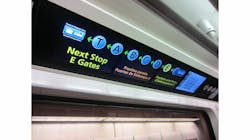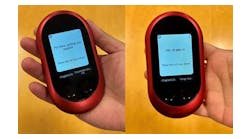Visitors to the largest corn maze in the world routinely dial 911 for assistance in navigating the labyrinth’s twists and turns. While no one calls the police for help journeying through an airport’s maze of walkways, tunnels and gates, passengers can still get equally lost.
From the moment passengers enter an airport facility they need to make their way somewhere, be it a check-in counter, security or their gates. Things become even more complicated in major airports, such as Hartsfield-Jackson Atlanta International Airport, which take their passengers underground to a transportation mall equipped with Automated People Movers (APM) to move them from place to place.
“People tend to get confused about exactly where they are when they’re in our underground transportation mall,” says Steve Poerschmann, director of Aviation Transportation Systems at Hartsfield-Jackson Atlanta International Airport.
Knowing this, Poerschmann’s team set out to find better way-finding technology for the world’s busiest airport’s transportation mall and on the APMs that move passengers throughout the facility. “The impetus was to better communicate with our passengers; it’s something we’re always trying to improve,” he says.
The airport solved this problem with a new technology from Advanced Application Design. The Wilmington, N.C.-based company’s ICONS line of digital signage replaces scrolling LED signs on the inside of APMs or light rail train cars and provides graphic, multilingual way-finding in addition to audio announcements and advertising.
To date, the airport has invested $2.7 million in 374 ICONS displays in order to provide six signs in every one of its 59 Bombardier APM cars and have 20 spares on hand, and to upgrade its fiber optic network as well as add more WiFi antennas to transportation mall equipment rooms and tunnels to enable the cars and signs to communicate as they traverse through the transportation labyrinth.
Though a sizable capital expense, Poerschmann indicates that using these signs to also advertise concessions and retail outlets will pay for the project. “The life expectancy of these displays is five to seven years,” he says. “If we’re able to generate the amount of revenue we think we can on a consistent basis, we’ll get a seven- to eight-fold return on our investment during that timeframe.”
SUBHEAD: Bettering Passenger Communications
The ICONS installation grew out of two different projects that the airport had going on simulataneously, according to Poerschmann. Part of the airport construction project on the Maynard H. Jackson Jr. International Terminal and its new concourse F included expanding The Plane Train APM system. But the old LED signage, installed on the cars above the doors and centerpoints, was obsolete.
“The original manufacturer didn’t service the signage anymore and didn’t make a replacement for it,” says Poerschmann. “We had no way of going back and programming the existing signage on the vehicles to expand the system to Concourse F.”
Though they found they could purchase similar signage from another vendor, the price for that signage was pretty steep—the airport not only had to replace the signage on its existing Bombardier Innovia APM 100 Series cars, but on the 10 new cars they were adding. “In order to maintain the same frequency of cars at each concourse, we needed to be able to put additional trains out on the system,” Poerschmann explains.
As the airport canvassed the digital signage market for replacement signs, Advanced Application Design approached them about customizing a product for them. The product would fit into the existing sign space and provide the capability for high-definition graphics on the displays. “At that time no one else was manufacturing a display that would fit into existing signage space on the vehicle,” he says. “When we went through the review process, part of the discussion centered on actual aesthetics and the appeal of the signage to passengers. In the end we chose Advanced Application Design to develop a product for us.”
Advanced Application Design worked closely with Bombardier to ensure the signage software communicated with the cars so that the signs were triggered with accurate vehicle location information and could queue up the right graphics at the right time. The signs offer multilingual capabilities, which contribute to the welcoming aspect of the airport for its international travelers. The signs offer multi-channel capability and greater computer storage capacity which translates into a wider variety of audio announcements available for broadcast to passengers.
As this first project got underway, a second project arose when the airport moved from a 25 kHz communications system to a 12.5 khz system to comply with an FCC-mandated narrow-banding scheme for mobile radio systems to provide more space in the UHF and VHF frequency Spectrum for the growing demand for communications. Airport officials decided it was the right time to upgrade the public address systems onboard the vehicles, and asked Advance Application Design if the computers used in the signage could provide public address capabilities as well.
Bombardier and Advanced Application Design again teamed together to create a public address communications system. As a result of their efforts, the signs offer multilingual capabilities, which contribute to the welcoming aspect of the airport for its international travelers. The signs provide multilingual way-finding announcements in seven languages—French, German, Spanish, Arabic, Mandarin, Korean and Japanese. “These languages cover about 90 to 95 percent of the international travelers that transit through the airport,” says Poerschmann.
While the system offers many benefits, an important consideration with this type of technology is service and maintenance. But Advanced Application Design has that covered, says Barry Vaughn, chief operating officer with the company.
Advanced Application Design’s annual maintenance contract includes remote maintenance and monitoring of both station and in-car signage. The company proactively identifies issues and takes steps to address them, often before the customer is aware that there is a problem, according to Vaughn. They also provide software updates, quarterly inspections, and regular cleaning and replacement of components.
SUBHEAD: Next Steps
Today the signs have been expanded to provide location-specific concessions listings, but the Advanced Application Design plans to add dynamic commercial advertising capabilities to Hartsfield-Jackson’s ICONS signs in 2015, when a portion of the signs in every vehicle will be dedicated to advertising space. “This will create a platform for new non-aeronautical revenue streams for the airport,” says Poerschmann.
He points to the success the airport had when it added window cling advertising to the center two windows on each vehicle. Passengers view the advertising as the APMs move through the airport. “So far from just those window clings we’ve generated almost $696,000 of non-aeronautical revenue through the end of October this calendar year,” Poerschmann says. “
Six months ago, the airport added vinyl clad advertisements to APM station doors as well. “We’ve already generated another $630,000 in revenue because of that,” he says. “The airport's share is approximately $860,000 of the money from both sources. We think the potential for advertising in the transportation mall is huge. And we believe the potential for dynamic advertising is even greater than what we’re currently getting from static advertising.”
ICONS signage offers very high resolution (greater than 5K pixels horizontally) and can clearly display high definition images or screens with a lot of information. Likewise, ICONS signs drive the audio in the vehicles so video ads with synchronized audio can be played on one, two, three or all four panels in each sign.
Because all advertising content physically resides on the computers in the ICONS displays, the content can be streamed into the APMs as they move around the underground transportation system. The data is fluid and can be quickly changed. “If one concessionaire terminates their agreement, we can quickly update that information and put a new concessionaire in their place, which saves costs to the airport because we no longer have to print out new hard displays or coordinate these changes far in advance,” he says.
The future appears very bright for this technology, both at Atlanta, who is currently working to add it to its ATL SkyTrain people movers to its Rental Car Center, and to other airports as well.
“It is a smart signage network that provides information to passengers relavant to the location of the train within the airport,” Vaughn says. “This technology has promising application for both inbound and outbound passengers. Inbound APM riders can be educated on the many options available at the airport and city--restaurants, rental cars, hotels, sightseeing. Airports with significant international traffic can display messaging in any language and any airport can customize welcome messages for special events such as sports or conventions. Outbound passengers benefit from very granular train arrival and departure info in order to get to their departure gates on time.
“And if passengers are early--which frequently happens these days--they are alerted to dining, shopping and other options available to them which usually involves spending money,” he adds.
Smart signage technology is a win for the passengers who can find their way around the airport more readily, and a win for airports that can boost their revenues by having it.



